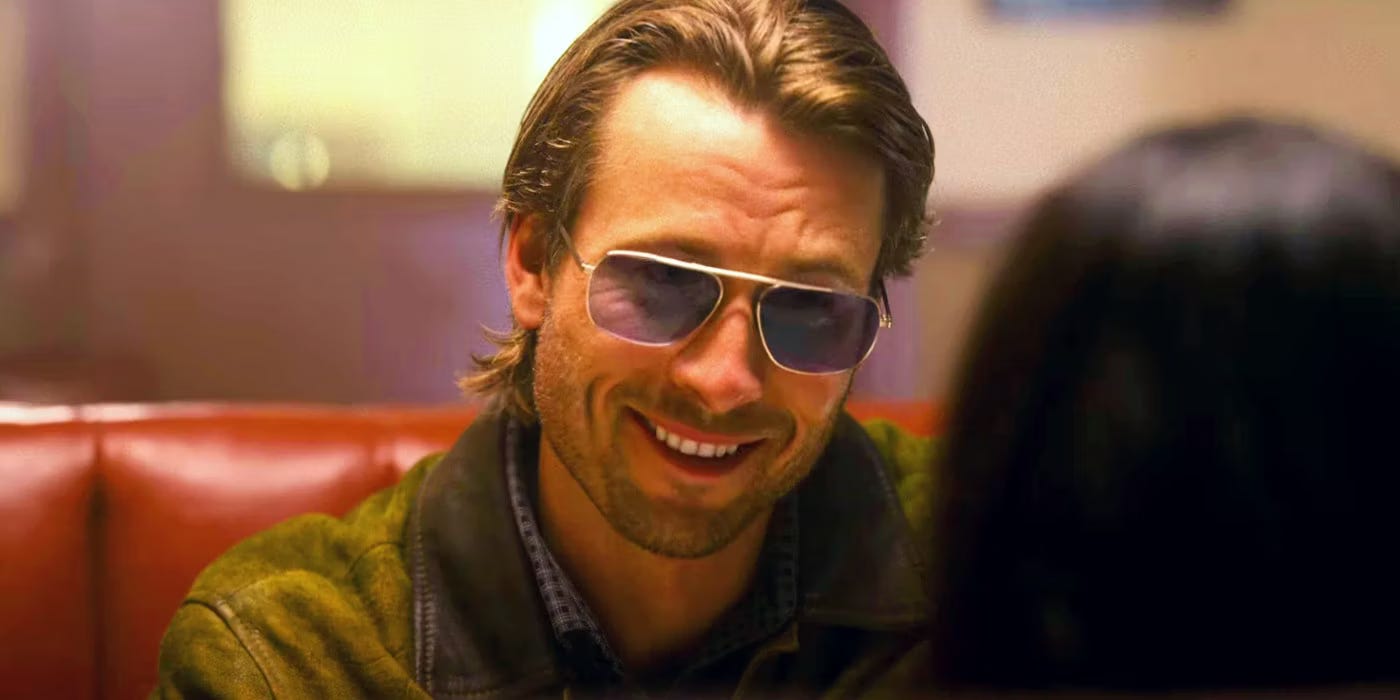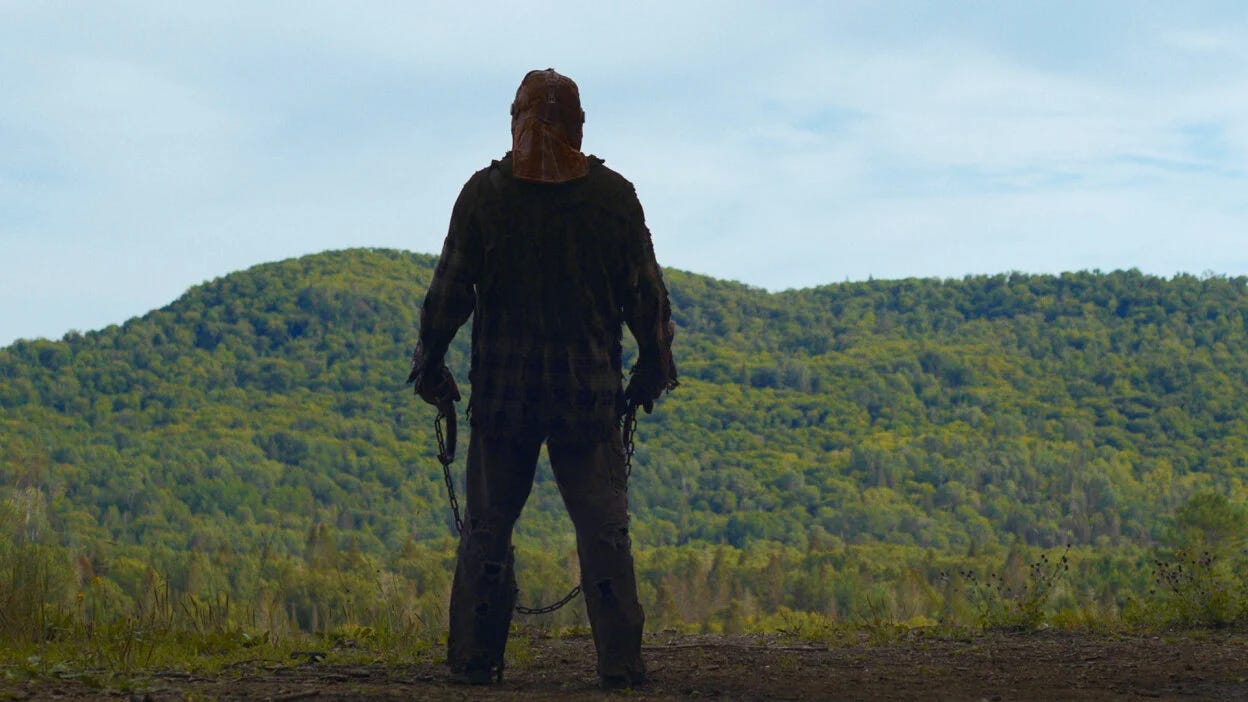
In Review: 'Hit Man,' 'In a Violent Nature'
Richard Linklater's latest casts Glen Powell as psychology professor with a double identity and a new slasher film finds a fresh angle on an old genre.
Hit Man
Dir. Richard Linklater
115 min.
One of the complaints most frequently lobbed against Superman concerns the thinness of his secret identity. Could a slouch, a pair of glasses, and an ill-fitting suit really disguise enough a Man of Steel? While, admittedly, Lois Lane, Jimmy Olsen, and other close companions being unable to see through the flimsy façade strains credulity, Superman could almost certainly get away with it based on the life of Gary Johnson, a Texas psychology professor whose background as a military police officer allowed him to pursue second career in law enforcement simultaneously. People often see what they want or expect to see and Johnson knew how to use this to his advantage. Starting in the late 1980s, Johnson developed a specialty impersonating hired killers for those seeking such services to eliminate the wives/husbands/business partners/lovers/whoever-they-wanted out of their lives, permanently. Doing this meant adopting a range of personae to suit his prospective clients. In the 2001 Skip Hollandsworth Texas Monthly profile “Hit Man” that inspired Richard Linklater’s new film of the same name, Hollandsworth calls him “the Laurence Olivier of the field.”
After Bernie, this is Richard Linklater’s second adaptation of a Hollandsworth article. But where Bernie was an exercise in illustrating how fact is sometimes stranger than fiction, Hit Man has a different agenda. The film uses the story as fodder for laughs, as one client after another gets taken in by the newly emboldened, chameleonic Gary, and as a jumping off point to explore questions about what makes up our identities and what, if anything, can truly alter them. Then it changes course a couple of times, touching on noir and romance, before leaving the world of fact entirely. Like its main character, it’s a film in the midst of an ongoing identity crisis, but of the thoughtful, productive sort.
It’s also the best showcase yet for the charms of star Glen Powell, who co-wrote the script with Linklater andwho’s just as convincing as the semi-nebbish behind the film’s gee-whiz narration as the sexier, more daring man Gary (maybe) becomes. Gary’s semi-engaged students know him as the mild-mannered professor who delivers lectures about Freud’s conception of the psyche. His neighbors in the nondescript New Orleans suburb he calls home know him as the guy with the cats who keeps to a predictable schedule and drives a Honda Civic. Even his semi-secret life as a part-time employee of the NOPD assisting with sting operations isn’t all that glamorous. He’s reliable and knows his way around recording equipment. He has his role and he plays it.
That changes, however, when Jasper (Austin Amello), the sleazy undercover agent who usually plays the part of would-be hit men, gets suspended, requiring Gary to wear a wire and keep a client talking until he incriminates himself. He pulls it off, but pulling it off also seems to unlock something inside Gary he didn’t know was there. He soon finds himself committing to the assignment with a Method actor’s dedication, posing as a sleazy redneck, a terse Russian, or whoever else a client might require. But when Gary, in the guise of a sympathetic assassin named “Ron,” meets with Maddy (Adria Arjona), a frightened wife looking for a way out of an awful marriage, he can’t seal the deal. Then he finds he can’t stay away from her. Or maybe it’s Ron who can’t. Either way, it could mean trouble.
Movies that mix crime and comedy often struggle to veer from one tone to another. That’s not really an issue with Hit Man, which vacillates between “frothy” and “fizzy” no matter how high the story’s stakes get or how dark it threatens to turn. The lightness is also a bit deceptive. Early on, Gary has a conversation with his ex-wife Alisha (Molly Bernard) about whether people are capable of change. Alisha’s affection for her ex is as obvious as her continued exasperation with the seemingly unshakeable timidity that drove her away. But the film, and its final scenes in particular, leave open the question of whether or not change is always for the better.
Yet it’s not that open a question. Powell and Arjona have a sparky chemistry that ignites into a bonfire over the course of the film as Gary discovers that, whatever its perils and however much deception it entails, it’s a lot more fun and exciting to live as Ron. If what used to be Gary threatens to fall away in the process, maybe that’s not such a loss. Hit Man is ultimately a bit too fun to engage fully with the questions it raises, but perhaps that’s not such a loss either. It offers too good a time to worry about any hangover. —Keith Phipps
Hit Man is currently in select theaters. It debuts on Netflix on June 7th.
In a Violent Nature
Dir. Chris Nash
94 min.
The term “elevated horror” is usually attached to artier (and often less graphic) genre fare, but it’s always felt like an insult to horror fans, who are presumed to wade in the filth that directors of refinement and taste have transcended in one way or another. And so it’s something of a relief that In a Violent Nature isn’t necessarily as elevated as it appears to be, despite applying the style of Gus Van Sant’s “Death Trilogy” (Gerry, Elephant, and Last Days) to the sorts of deaths that you might expect around Crystal Lake. Written and directed by Chris Nash, the film is a true high/low proposition, committing rigorously to a camera technique of forced perspective and oddly serene, mesmeric rhythms while respecting the gruesome traditions of a slasher film. It’s a Venn diagram for appreciators of Béla Tarr and dismemberments.
Frankly, that makes it sound a little cooler than it turns out to be. Once it’s clear what Nash is attempting to do, the fusion food is mostly plated and served, without much in the way of surprising flavors. Yet it’s thoroughly compelling all the same, as Nash assembles a half-dozen or so young people for a weekend in the woods and sets a hulking man-beast loose to kill them one-by-one, using an array of old-school implements of death. After a couple of visitors trod gracelessly on the wrong patch of ground, out emerges a subhuman creature from the forest floor who immediately seeks out the first person he can bludgeon to death. In a twist on the first-person camera that would become a slasher-movie cliché after Black Christmas and Halloween, Nash follows the killer from the back in a close-to-medium distance as he plods his way to the scene.
As it happens, local legend identifies this vengeful spirit as Johnny (Ry Barrett), once a mentally disabled child tormented by loggers and now a campfire story come to life for his eventual victims. Once Johnny sets to work on them, In a Violent Nature turns into a lyrical grind, pausing to soak in the sun-kissed trees and the quiet sound of birdsong and boots crunching on leaves between a succession of kills. Though Nash seems intent on making the victims as colorless and banal as possible, he invests heavily in cool kills having an impact: Bodies are turned into soft, pliant pushpins for sharp objects to penetrate. The gore is so extreme that it turns into dark comedy, as Johnny cannot stop himself from destroying bodies for sport. Credit Nash for ultimately not caring much for his film to be elevated, though perhaps a little more ambition might have helped. — Scott Tobias
In a Violent Nature opens in select theaters tomorrow.




















Me sure me not first person to pose this question, but is Linklater our best working director who not have any particular style? Could anyone else have done Before movies, School of Rock, Waking Life, and this movie equally well?
I’m quite a bit higher on IN A VIOLENT NATURE than Scott is, in spite of what appears to be a failure of nerve in the home stretch. I’m planning on going back again this weekend to see if the ending plays better when you know it’s coming.